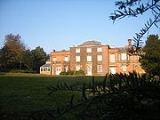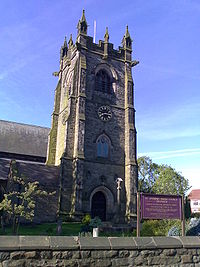
Swanwick, Derbyshire
Encyclopedia
Swanwick is a village in Derbyshire
, England
, also a Parish within the Amber Valley
district, with a population
of 5,316 at the 2001 census.It has a number of shops, pubs and other businesses, a Church of St Andrews, as well as Methodist
and Baptist
churches. In the northern part of the Parish an industrial estate on the former Swanwick Colliery site incorporates the Thornton's Confectionery factory along with other businesses. Now largely urbanized, the Parish still has some remaining agricultural land to the north and west.
Several families figure highly in Swanwick's long history. The Turners, beginning with George Turner in 1620, owned the local mineral rights and became coal magnates, until the death of Charles Turner in 1736. John Turner built Swanwick Hall around 1690. Elizabeth Turner had a school built in 1740 to provide education for 20 children from poor families. The school house is now a private residence. The other most significant family was the Woods, who occupied the original Swanwick Hall ('The Old Hall') in what is known as Wood's Yard. It was a substantial yeoman's residence of 1678, as evidenced by a datestone
high up on the dormer gables, along with the crest adopted by the Wood family. The Woods succeeded the Turners as owners of most of the local mineral rights, and Hugo Wood later moved into the newer Hall with his family; a painting of his children, by Joseph Wright of Derby
, used to hang in its dining room. The Hall opened as a secondary school in 1922, the Derbyshire County Council having bought it two years earlier after the death of Hugo Wood.
Swanwick Hayes – now the Hayes Conference Centre
– was constructed in the 1850s as the home of Mr Fitzherbert Wright. In the early 1900s, it was converted into a conference centre, and operates as such to this day. The Hayes gained notoriety during World War II
, when it served as a prisoner of war
camp for both German and Italian prisoners. Franz von Werra
, a Luftwaffe officer, escaped from here; he was recaptured at nearby RAF Hucknall, while trying to steal an aircraft. A film entitled The One That Got Away, and starring Hardy Krüger
, was made of his exploits.
 The village has four schools: Swanwick Hall, Swanwick Primary School, Swanwick Pre-School and Swanwick School & Sports College.Swanwick Hall specialists on Technology
The village has four schools: Swanwick Hall, Swanwick Primary School, Swanwick Pre-School and Swanwick School & Sports College.Swanwick Hall specialists on Technology
Derbyshire
Derbyshire is a county in the East Midlands of England. A substantial portion of the Peak District National Park lies within Derbyshire. The northern part of Derbyshire overlaps with the Pennines, a famous chain of hills and mountains. The county contains within its boundary of approx...
, England
England
England is a country that is part of the United Kingdom. It shares land borders with Scotland to the north and Wales to the west; the Irish Sea is to the north west, the Celtic Sea to the south west, with the North Sea to the east and the English Channel to the south separating it from continental...
, also a Parish within the Amber Valley
Amber Valley
Amber Valley is a local government district and borough in Derbyshire, England. It takes its name from the River Amber and covers a semi-rural area with a number of small towns formerly based around coal mining and engineering...
district, with a population
Population
A population is all the organisms that both belong to the same group or species and live in the same geographical area. The area that is used to define a sexual population is such that inter-breeding is possible between any pair within the area and more probable than cross-breeding with individuals...
of 5,316 at the 2001 census.It has a number of shops, pubs and other businesses, a Church of St Andrews, as well as Methodist
Methodism
Methodism is a movement of Protestant Christianity represented by a number of denominations and organizations, claiming a total of approximately seventy million adherents worldwide. The movement traces its roots to John Wesley's evangelistic revival movement within Anglicanism. His younger brother...
and Baptist
Baptist
Baptists comprise a group of Christian denominations and churches that subscribe to a doctrine that baptism should be performed only for professing believers , and that it must be done by immersion...
churches. In the northern part of the Parish an industrial estate on the former Swanwick Colliery site incorporates the Thornton's Confectionery factory along with other businesses. Now largely urbanized, the Parish still has some remaining agricultural land to the north and west.
History
The name Swanwick is derived from the Old English 'Swana' meaning herdsmen, and 'wic' meaning a group of buildings.The settlement is thought to have begun in the vicinity of the farm above The Hayes (meaning 'enclosure'), on which a number of ancient footpath routes converge. It is first mentioned in 1304 in Sir Thomas Chaworth's grants to Beauchief Abbey. Sir Thomas was the Lord of the Manor of Alfreton, which encompassed Swanwick. The area was exploited for coal from early times, first with small pits in the locality known as The Delves (meaning 'diggings') and later with a major colliery in the north of the parish, which closed in the 1960s.Several families figure highly in Swanwick's long history. The Turners, beginning with George Turner in 1620, owned the local mineral rights and became coal magnates, until the death of Charles Turner in 1736. John Turner built Swanwick Hall around 1690. Elizabeth Turner had a school built in 1740 to provide education for 20 children from poor families. The school house is now a private residence. The other most significant family was the Woods, who occupied the original Swanwick Hall ('The Old Hall') in what is known as Wood's Yard. It was a substantial yeoman's residence of 1678, as evidenced by a datestone
Datestone
A datestone is typically an embedded stone with the date of engraving and other information carved into it. They are not considered a very reliable source for dating a house, as instances of old houses being destroyed and rebuilt have been reported.Specific locations have often been chosen for...
high up on the dormer gables, along with the crest adopted by the Wood family. The Woods succeeded the Turners as owners of most of the local mineral rights, and Hugo Wood later moved into the newer Hall with his family; a painting of his children, by Joseph Wright of Derby
Joseph Wright of Derby
Joseph Wright , styled Wright of Derby, was an English landscape and portrait painter. He has been acclaimed as "the first professional painter to express the spirit of the Industrial Revolution"....
, used to hang in its dining room. The Hall opened as a secondary school in 1922, the Derbyshire County Council having bought it two years earlier after the death of Hugo Wood.
Swanwick Hayes – now the Hayes Conference Centre
Hayes Conference Centre
The Hayes Conference Centre is a group of buildings in Swanwick, UK which are used for conferences and other functions. The building which now houses the centre's reception was built in the 1850s as a private residence and named Swanwick Hayes...
– was constructed in the 1850s as the home of Mr Fitzherbert Wright. In the early 1900s, it was converted into a conference centre, and operates as such to this day. The Hayes gained notoriety during World War II
World War II
World War II, or the Second World War , was a global conflict lasting from 1939 to 1945, involving most of the world's nations—including all of the great powers—eventually forming two opposing military alliances: the Allies and the Axis...
, when it served as a prisoner of war
Prisoner of war
A prisoner of war or enemy prisoner of war is a person, whether civilian or combatant, who is held in custody by an enemy power during or immediately after an armed conflict...
camp for both German and Italian prisoners. Franz von Werra
Franz von Werra
Franz Xaver Baron von Werra was a German World War II fighter pilot and flying ace who was shot down over England and captured...
, a Luftwaffe officer, escaped from here; he was recaptured at nearby RAF Hucknall, while trying to steal an aircraft. A film entitled The One That Got Away, and starring Hardy Krüger
Hardy Krüger
Hardy Krüger is a German actor. He is thought of as one of the greatest German actors of the 1960s. He was born in Wedding, Berlin, German Reich...
, was made of his exploits.
Schools


